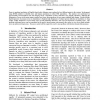Free Online Productivity Tools
i2Speak
i2Symbol
i2OCR
iTex2Img
iWeb2Print
iWeb2Shot
i2Type
iPdf2Split
iPdf2Merge
i2Bopomofo
i2Arabic
i2Style
i2Image
i2PDF
iLatex2Rtf
Sci2ools
LREC
2010
2010
Evaluation of Machine Translation Errors in English and Iraqi Arabic
Errors in machine translations of English-Iraqi Arabic dialogues were analyzed at two different points in the systems development using HTER methods to identify errors and human annotations to refine TER annotations. The analyses were performed on approximately 100 translations into each language from 4 translation systems collected at two annual evaluations. Although the frequencies of errors in the more mature systems were lower, the proportions of error types exhibited little change. Results include high frequencies of pronoun errors in translations to English, high frequencies of subject person inflection in translations to Iraqi Arabic, similar frequencies of word order errors in both translation directions, and very low frequencies of polarity errors. The problems with many errors can be generalized as the need to insert lexemes not present in the source or vice versa, which includes errors in multi-word expressions. Discourse context will be required to resolve some problems wi...
| Added | 29 Oct 2010 |
| Updated | 29 Oct 2010 |
| Type | Conference |
| Year | 2010 |
| Where | LREC |
| Authors | Sherri L. Condon, Dan Parvaz, John S. Aberdeen, Christy Doran, Andrew Freeman, Marwan Awad |
Comments (0)

